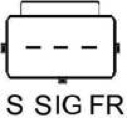THIS BULLETIN ONLY APPLIES IF YOU HAVE THE FOLLOWING 3-PIN STRIP PLUG ON THE ALTERNATOR:

A known fault exists which can result in a charging fault. This can be the alternator showing as overcharging and/or charging with the warning light on. This alternator is operated through a smart charge system, if the battery being used on the vehicle is standard lead type battery and not the recommended silver-calcium then the alternator may not function correctly, the battery voltage should be around 13.8V in order for the alternator to function correctly.
Checking the Smart Charge System
A/S pin (Battery Sensor / Reference Voltage): Must match the battery voltage. The feed is from the central junction box in the engine bay. A high resistance on the fuse contact can cause a voltage drop resulting in the smart charge dropping out.
SIG (Alternator Load Request) and FR Pin (Alternator Feedback): The two pins need checking back to the PCM for resistance by isolation from ground and each other. If this test is ok the you will need to use a scope for the following tests
SIG Pin: This pin requests the load from the PCM to the alternator. This will be a square wave pattern that will change with load request. Switch on lights, heaters etc. for this test back probing with the plug connected. If there is no change in the patterns this would indicate a possible PCM fault.
FR Pin: This pin is the feedback from the alternator and must remain in a constant square pattern. If the pattern mirrors the SIG pin pattern this would indicate a possible alternator fault.
Ensure the battery is fully charged before fitting the alternator. Do not attempt to jump-start the vehicle. This alternator can run up to 18v. Jump-starting can damage alternator components.
If the above fault exists on the vehicle first check the wiring loom which is around 40cm long. Ensure there are no breaks or corroded terminals as any defects will stop the alternator from functioning correctly. If any defects are found it is recommended that the wiring loom be replaced. If no faults are found with the wiring there may be a fault with the ECU.
Failure to rectify the above fault will result in the premature failure of the alternator or will result in the fault being incorrectly diagnosed and may invalidate your warranty.



